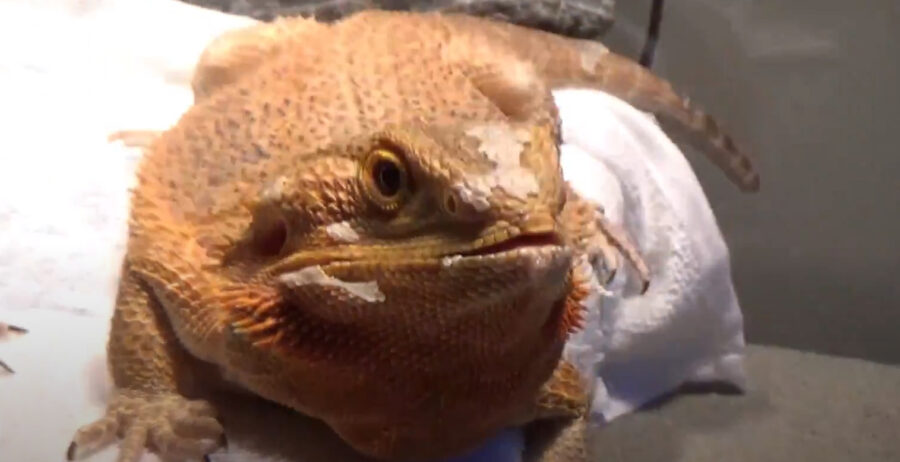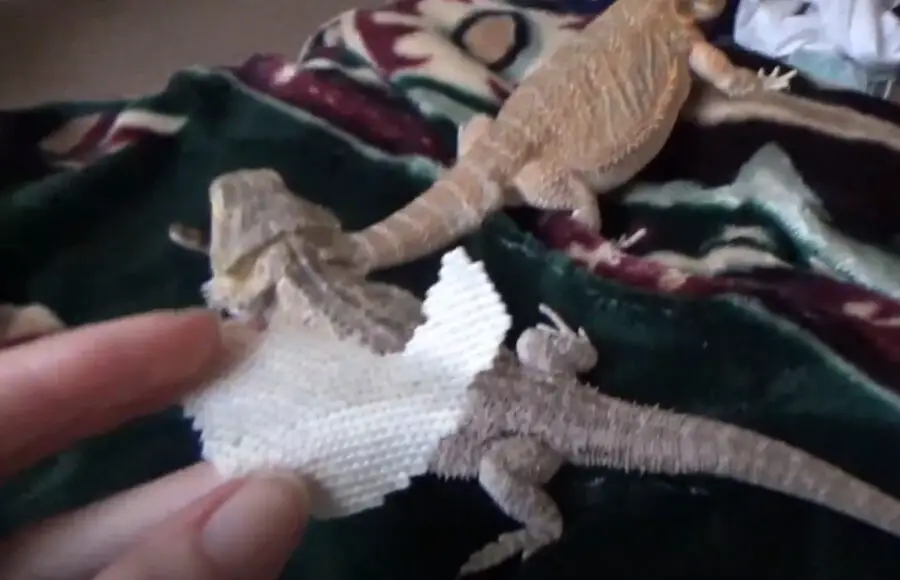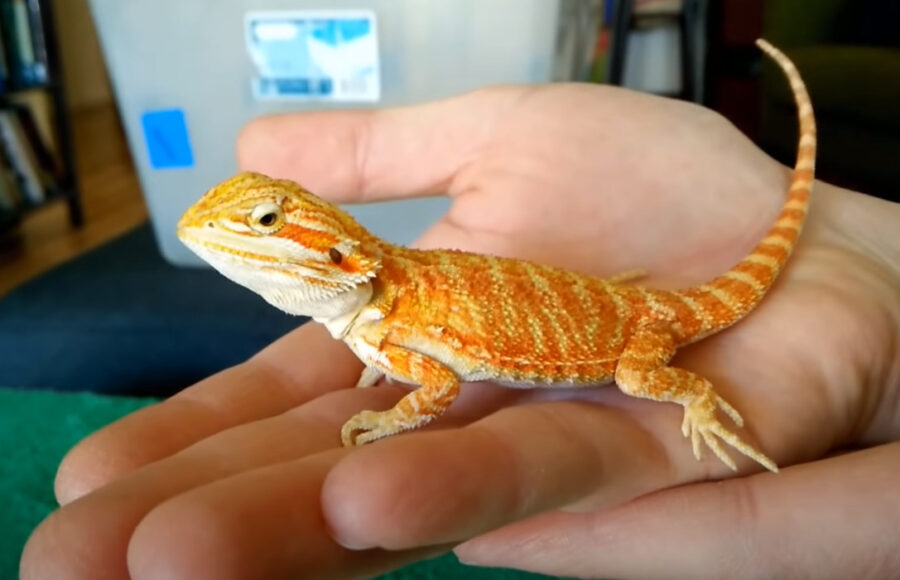One of the unique adaptive behaviours of a bearded dragon is shedding.
Do you know how often or why bearded dragons shed?
Bearded dragons usually shed with different frequencies at various stages of their growth. Below I will cover at which stages you need to know about.
How Often Do Bearded Dragons Shed Their Skin?
A bearded dragon will tend to shed more within the first six months of their lives. They usually shed almost every week within this period. After six months of age they will tend to shed only 2 – 3 times a year.
The shedding progressively reduces as they grow but does not stop. The next 6-12 months will see them shed only twice a month. Shedding in bearded dragons 18 months old and above will only occur a couple of times in a year.

What Do You Do When Your Bearded Dragon Is Shedding?
Shedding is a natural process for them, and they tend not to need much of your help. Nevertheless, you have to understand that shedding is a critical part of the lives of bearded dragons, and you have to make it as easy for them as much as possible.
You can still take specific steps to make the process relatively more comfortable for them, particularly in captivity.
You can start by enhancing the setup by providing them with things that will help them aid the process. It will help you provide them with materials like branches, rocks, substrate, and branches.
Aside from the fact that these materials will help them simulate their natural environment, it will also help them dislodge and loosen a shedding body area.
If bearded dragons are in captivity, ensure that you help them get the right environmental condition. Ensure that they are getting the appropriate heat and light gradient.
Likewise, you should ensure that you provide them with a suitable diet and enough hydration to help them with the process.
A little extra humidity will help, as well. This process can stimulate the natural burrowing techniques of bearded dragons in the wild. They usually burrow where the humidity can reach 80% to help them soften the shedding skin.
I recommend to spray them with water a few times a day to keep them hydrated.
You can also give them a bath o help with their shedding process. This process will provide them with additional misting; and it should be done with hot water and not so toasty.
It is better to let them enjoy the bath on their own and not be too hands-on with them during the bath. Using appropriate shedding bath formulae can be of help also.
However, you should avoid trying to help them pull the skin off or attempt to peel the skin for them. Similarly, trying to offer assistance like bathing or oiling might not be necessary for this process.
How Long Does It Take For A Bearded Dragon To Shed?
Bearded dragons do not take too much time to finish shedding. The entire process of this shedding does not exceed 7 days (one week). It might take a little longer time occasionally, but it is no problem at all.
The frequency or time taken to shed is dependent on different factors, particularly the age of the bearded dragon. Shedding within the first six months of their life will not take more than a week.
Shedding within 6 to 12 months might take a few more days because the growth is no longer rapid.
At 12-18 months, bearded dragons will shed less frequently, but you can expect it to take a little longer time.
Why Do Bearded Dragons Shed Their Skin?
Many things about nature raise man’s curiosity, and shedding in bearded dragons is one of them. Shedding is not only peculiar to bearded dragons. It is common among reptiles.
Shedding is a natural process where skin dies, and they are replaced. Therefore, the primary reason for shedding in bearded dragons is growth. However, bearded dragons might also be relieved if they suffer from the infestation of mites and other parasites.
Bearded dragons will also shed if the skin becomes damaged and needs to be replaced. Adults free their skin less frequently, and the primary reasons for their shedding are stress, breeding, change in diet, humidity, and temperature.
How Often Do Bearded Dragon Shed?
The frequency of shedding in the bearded dragon is mainly dependent on age. Younger bearded dragons shed more frequently than adults because of their rapid and active growth.

In the first six months (0-24 weeks), bearded dragons will shed more often. Shedding happens almost every week due to the active growth of this phase. Shedding is also quite different from the adults because the shedding will take place through their bodies.
In the next six months (24-48 weeks), the shedding becomes less frequent. The growth rate will be slowed down, and shedding will only take place mostly twice a month. After attaining one year, the frequency of shedding will drastically reduce. On average, they will only shed a few times per year at this age.
After 18 months or older, shedding becomes sparse because muscle and skin growth are done. They will only shed a few times in a year. It will appear more like a skin refresher than a necessary process in younger bearded dragons.
Do Baby Bearded Dragons Shed Their Skin?
Of course, baby bearded dragons do shed their skin. Skin shedding is more frequent in the first six months of life. This regular skin shedding is because of their active growth.
Therefore, if you find your baby bearded dragons shedding their skin, it’s nothing serious. It is a natural process.

What to Do When Bearded Dragon Shed Won’t Come Off?
Of course, issues can arise during shedding like every other natural process. It might result in a slight complication for the when bearded dragon.
However, if you put everything in place, there will be little or no chance of complications during shedding, as highlighted above. Shed not coming off in bearded dragons is particularly common to specific areas like belly, head, feet, tail, and eyes.
One of the main reasons why the shed won’t come off is the lack of substrates. Bearded dragons use substrates to remove the peeling skin from their body.
In this case, consider the addition of suitable substrates for them.
You can also consider enhancing the humidity of their environment to reach about 80%. The moisture in this humidity will help the bearded dragons to soften their skin, and make it easy for it to come off.
Lack of essential vitamins is another primary reason the dragon shed might not come off. The most bearded dragons that have issues while shedding are usually vitamin B deficient.
The addition of supplements that contains the necessary vitamins will also help them to get the skin off.
Nevertheless, you should never attempt to help bearded dragons pull off their skin even if they don’t come off. Trying this will do more harm than good to them.
Why Is My Bearded Dragon Shedding So Much
Excessive shedding in bearded dragons can be attributed to various factors, including environmental conditions, health issues, and age. Here are some possible reasons why your bearded dragon may be shedding excessively:
- Growth and Development: Juvenile bearded dragons tend to shed more frequently than adults as they go through rapid growth and development. During this stage, shedding is a natural process as the dragon’s body outgrows its skin.
- Shedding Cycle: Bearded dragons typically shed their skin in regular intervals. However, individual dragons may have variations in their shedding patterns. Some dragons may shed more frequently or have more noticeable shedding cycles compared to others.
- Inadequate Humidity: Proper humidity levels are essential for healthy shedding in bearded dragons. If the humidity in the enclosure is too low, it can lead to dry and retained shed. Inadequate humidity can cause the shed skin to stick to the dragon’s body, making it difficult to shed properly.
- Poor Nutrition or Dehydration: Nutritional deficiencies or dehydration can impact the health of a bearded dragon’s skin. Inadequate hydration and a lack of essential nutrients, such as vitamins and minerals, can affect the quality of the skin and result in abnormal shedding.
- Skin Infections or Health Issues: Certain health conditions, such as parasites, skin infections, or underlying metabolic issues, can cause abnormal shedding in bearded dragons. If you notice other signs of illness, such as loss of appetite, weight loss, or changes in behavior, it is important to consult a reptile veterinarian for a thorough examination.
To address excessive shedding, you can take the following steps:
- Ensure appropriate humidity levels in the enclosure. For bearded dragons, the humidity should be around 30% to 40%.
- Provide a shallow water dish for your bearded dragon to soak in to aid in the shedding process.
- Ensure a balanced and nutritious diet for your bearded dragon, including a variety of vegetables, leafy greens, and live insects.
- Regularly clean the enclosure to maintain cleanliness and prevent any potential skin irritants.
- If you suspect any underlying health issues, seek veterinary attention for proper diagnosis and treatment.
Do Bearded Dragons Stop Eating When They Shed?
Yes, like many other reptiles, bearded dragons might stop eating during shedding. This reaction is a common question among bearded dragon keepers.
Again, bearded dragons not eating during shedding is nothing serious to cause you to worry.
Shedding in bearded dragons might see them go off their food, hideaway, and become less active. However, this process shouldn’t result in weight loss because it will only take a few days.
If it becomes persistent, then you should visit your vet.
If your bearded dragon is not eating check out the below video for possible reasons why
Do Bearded Dragons Get Stressed When Shedding?
It might be unavoidable for bearded dragons to become stressed during shedding. They can even become irritable and exhibit other odd behaviors. They will even lose appetite and become less active.
You can quickly tell if your bearded dragon is stressed from the beard. The beard will become black while the other body color darkens or turns black as well.
You can also find bearded dragons surfing when they are stressed.
Is Shedding Painful For Bearded Dragons?
Shedding is a natural phenomenon, and it should ordinarily not be painful for bearded dragons. If they experience pain during shedding, it might mean that something is wrong.
Providing your bearded dragons with optimal conditions will make the shedding process as passive as possible.
One thing you must never do is trying to pull off the skin of a shedding bearded dragon. This action might leave it with damaged skin that will cause many pains and make them vulnerable to infections.
Conclusion
Bearded dragons are one of the most decorated reptiles by nature. It has a body structure that looks very much like that of a dragon; hence, its name. Its body is covered in the armor of reptilian scales that take the shape of spines.
The bearded dragon has spikes beneath it chin that appear like a beard. The beard only puffs off depending on the mood of your bearded dragon.
In general, bearded dragons seem to be slightly different from most other mammals because they are usually active during the day, gentle, and curious.
Bearded dragons might not be the cutest reptiles to keep as pets, but they are certainly among the most exciting species. Shedding is one of their natural phenomena, and you must understand what is going on with them.
Shedding in bearded dragons is more frequent in younger ones than adults. Likewise, the process is naturally passive and shouldn’t result in any complications if everything is right with them.


